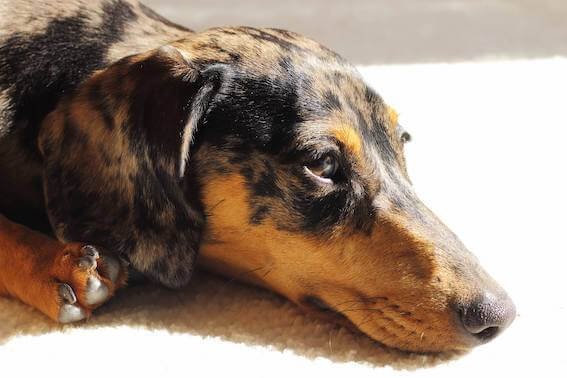Dachshund Breed Guide
Dachshunds, also often referred to as “sausage dogs”, are a small to medium-sized breed of dog known for its unique body shape and are part of the hound family. Dachshunds have elongated bodies and relatively short legs, which makes them easily recognisable. The breed originated in Germany around the 18th century with the name translating in German to “badger dog”, as the breed was originally developed to hunt badgers and other burrow animals, with miniatures used to hunt smaller animals like rabbits. Dachshunds have become a very popular breed over the years, especially in recent years due to many celebrity fans and references in popular culture, film and television, and as a result the breed has found their way into the hearts and homes of many dog lovers around the world.
What size are dachshunds and how long do they live for?
In the UK there are two accepted sizes for the breed according to the Kennel Club, standard and miniature. In the dachshund’s native country of Germany, there is a third smaller size known as “kaninchen” or rabbit dog and the difference between all three sizes is determined by measuring the circumference of the dog’s chest. In summary though, the difference between standards and miniatures in the UK is the size and weight. Standard dachshunds typically weigh around 9 to 12 kilograms (around 35–47 cm in height), with the accepted size for a miniature being under 5 kilograms (around 30–37 cm in height). You can get dachshunds that fall in between these two markers in size, and while there is no official breed standard that applies to dogs of that size, you may hear them unofficially referred to as “tweenie” size (in between size) meaning that they weigh between the accepted 5kg and 9kg that mark the top and bottom of the accepted size brackets. It is also possible for two miniatures to breed a litter of puppies that may grow into larger than miniature size dogs. We have written a full post on the differences between the two main different types of dachshunds, but this mainly comes down to size.
The typical life expectancy for a dachshund is around 12 to 16 years, but it can vary depending on various factors such as genetics, diet, healthcare, and overall living conditions. With proper care, attention to their specific needs, and regular veterinary check-ups, dachshunds can live a long, happy and healthy life. Dachshunds, like many small dog breeds, may be prone to certain health issues, including back problems, dental issues, obesity, and joint problems. Taking preventive measures, such as maintaining a healthy weight, providing regular exercise, and ensuring they have proper dental care, can help extend their lifespan and improve their quality of life.
What colour coats do dachshunds have?
There are three different types of coat across both the standard and miniature variety of dachshund - smooth haired, long haired and wire haired. There are a number of “accepted” coat colours within the UK Kennel Club Breed Standard. This includes Black & Cream, Black & Tan, Chocolate Dapple, Chocolate & Cream, Chocolate & Tan, Cream, Fawn, Red, and Silver Dapple.
There are a number of other colours that can be produced but are not accepted within the breed standard (although more are accepted in the USA by the American Kennel Club). The UK Kennel Club only advise selecting a dog that matches the breed standard, as the “other” colours can bring with them additional health risks and challenges, which can severely impair the dog and its quality of life. One such example is known as “double dapple” where two dappled coat dachshunds are bred together, which can bring significant health issues for the dog in question. These dogs usually have a lot of white in the coat, and may be completely white, with either one or both blue eyes, and this is usually accompanied by various degrees of vision and hearing loss (even complete blindness and / or deafness). Many of these colours may be advertised as “rare” or “unusual” by unscrupulous breeders, often with a huge price tag attached. With this in mind, it is always best to avoid any puppies labelled as such, and stick to the coat colours within the breed standard. We have a separate guide to choosing a dachshund breeder which contains some other useful advice and red flags to avoid based on our own experience and research when we were choosing our dog.
If in doubt and you’re concerned about the puppy you are interested in, I recommend checking the UK Kennel Club's official website or contacting them directly for the most up-to-date information on recognised coat colours and breed standards for Dachshunds in the UK.
Dachshund Temperament
Dachshunds are known for their playful and friendly nature, but they can also be courageous, determined and at times quite stubborn, so a good training routine and socialisation is key to raising a well behaved dachshund. Due to their original breeding as badger hunters, they have a natural prey drive and can have a tendency to chase small animals. Their stubborn traits can also sometimes make them hard to train, especially when it comes to toilet training and preventing accidents in the house. As a breed they can also be known to bark a lot, and sometimes may need further training or support to stop barking so frequently, as it can become excessive.
Dachshunds are pack dogs and tend to be very loyal to their family. Typically they are good around children, but it is advisable to ensure that any children are supervised with them just in case, and young children especially should be taught how to handle the dog gently and respect their boundaries. It is also important to ensure that the individual temperament of the dog is taken into consideration. Some dachshunds can be quite nervous or excitable so children running and shouting can be overstimulating. They can at time be wary of strangers and also prone to separation anxiety. However in general they are great family dogs. Proper socialisation from a young age is also key to helping dachshunds get along well with children, as early exposure to different people, situations, and environments can help them become more comfortable and confident. In general, with patience and consistent training, all of the more challenging dachshund traits are possible to overcome.
Dachshund Health Conditions
The most common condition that affects dachshunds is IVDD (Intervertebral Disc Disease) which can affect up to 25% of dachshunds at some point in their lifetime and can lead to back problems and mobility issues. It is important to make sure that you don’t let your dachshund become overweight, as this can place extra stress on the spine, putting the dog at greater risk of back issues. Proper handling, avoiding activities that strain the back, and providing supportive measures can also reduce the risk of back problems.
Dachshunds can also inherit other genetic conditions such as Progressive Retinal Atrophy (PRA) which is an inherited eye disease affecting miniature dachshunds, so it is important when selecting a puppy to make sure that both parents have been tested for this condition.

